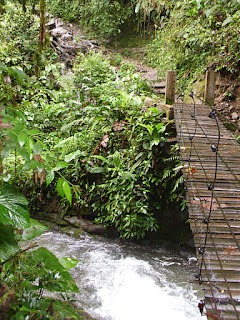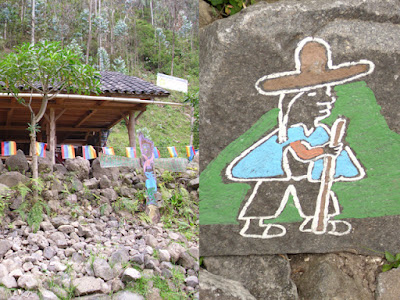Water rushes over our hiking path in Mindo, Ecuador. I try to cross without using my hands!
All the Quiteños know Mindo. They venture to this cloud
forest town for adventures in nature.
The editors of Lonely Planet don’t mention Mindo in their guidebooks, yet.
Once they do - once the town has a few ATMs, once there are a few places where it is possible to pay with a credit card - foreign tourists will storm it.
In order to visit, one must budget and bring cash.
Rather than made a reservation with one of the two or three sterile resorts that take them, it is best to set aside money for each day and stick to your limit. Follow your fellow tourists and join with them to collect discounts on common lodgings and activities.
Iona and I stay at La Casa de Cecilia. This is our ground floor room.
Once they do - once the town has a few ATMs, once there are a few places where it is possible to pay with a credit card - foreign tourists will storm it.
In order to visit, one must budget and bring cash.
Rather than made a reservation with one of the two or three sterile resorts that take them, it is best to set aside money for each day and stick to your limit. Follow your fellow tourists and join with them to collect discounts on common lodgings and activities.
Iona and I take a three hour bus ride from Quito’s Ofelia
bus station to Mindo.
As our driver ascends the switchbacks and the air begins to get thinner, mists roll in over the craggy, bromeliad and vine covered mountains.
As our driver ascends the switchbacks and the air begins to get thinner, mists roll in over the craggy, bromeliad and vine covered mountains.
Nature along the trail (clockwise from upper left): Morphos butterfly. A photogenic relative of the violet. A bromeliad sprouts up from a few slivers of rotten wood.
We arrive and find an English speaking tour operator across
the street from the bus station. Other tourists arrange for a waterfall tour
with us. Negotiating a group rate saves us $4 each.
With Nambillo Falls as our final destination, we hike past
seven smaller, equally spectacular waterfalls.
One of our Australian friends takes a solo dip in this lovely cascade.
Our entire party gets wet here. Iona and her friend are the last ones out from under the falls.
While everyone enjoys splashing in a waterfall, far tumbling
water feels deeper in significance for me.
These dramatic drops evidence the relative youth of the planet.
Where water has time to do its work, mountains are brought down to the size of
hills. Meandering brooks through a meadow are sometimes the only evidence that water was responsible.
Don't forget to use water tablets if you fill your canteen from these springs!
Iona backs me up as I hug a mossy tree.
Waterfalls demonstrate for how water connects all life. Once most of the planet was like the cloud forest: humid, dense with vines, difficult to navigate. Then the clouds came to earth in the form of water.
One of a number wood slat and cable bridges on the trail.
It was water that brought humankind to land and, with its kinetic force, water made a rough landscape habitable for humankind.
We leave Mindo grateful for - and in awe of - water.



















































